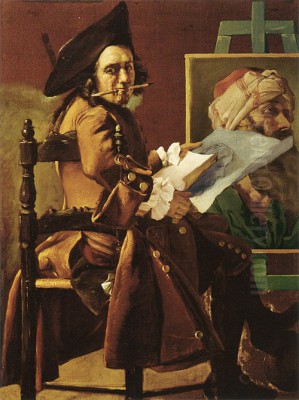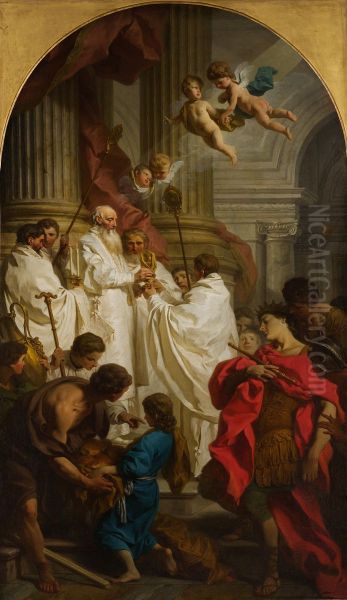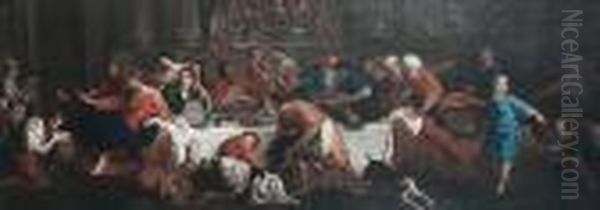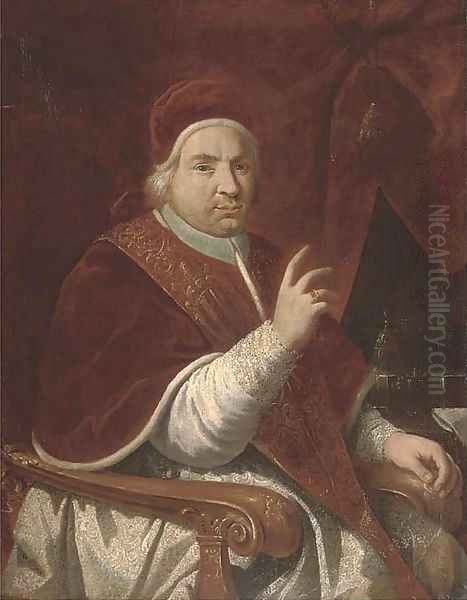
Pierre Subleyras stands as a significant, if sometimes underappreciated, figure in the rich tapestry of 18th-century European art. A French painter who found his greatest success in Rome, Subleyras masterfully navigated the stylistic currents of his time, producing works that resonate with the dramatic intensity of the late Baroque while heralding the clarity and refined sentiment of early Neoclassicism. His oeuvre, encompassing grand religious altarpieces, insightful portraits, and engaging genre scenes, reveals an artist of exceptional technical skill, profound psychological depth, and a distinctive sensitivity to color and light.
Early Life and Artistic Formation in France
Born on November 25, 1699, in Saint-Gilles-du-Gard in southern France, Pierre Subleyras was immersed in the world of art from a young age. His father, a painter of modest reputation, provided his initial instruction. This early exposure undoubtedly laid the foundation for his technical abilities. Seeking more formal training, the young Subleyras moved to Toulouse, a vibrant artistic center in southern France.
In Toulouse, he entered the studio of Antoine Rivalz (1667-1735), a prominent local painter and engraver. Rivalz, himself a product of Roman training and a member of a distinguished family of artists and architects, was a key figure in the Toulouse art scene. Under Rivalz's tutelage, Subleyras honed his skills, not merely as a student but eventually as a trusted assistant. This period was crucial for developing his draftsmanship and understanding of composition, likely absorbing Rivalz's own blend of French academic tradition and Italian Baroque influences. The artistic environment of Toulouse, though provincial compared to Paris, offered a solid grounding in the prevailing artistic conventions of the era.
The Path to Rome: Academic Triumph
The ambition of any aspiring French history painter in the 18th century was to study in Rome, the cradle of classical antiquity and Renaissance mastery. The most prestigious route to this goal was through the Royal Academy of Painting and Sculpture in Paris and its coveted Prix de Rome. Subleyras, demonstrating his burgeoning talent, made his way to Paris to compete.

In 1727, his efforts were crowned with success. Subleyras won the first prize in the Academy's competition, a distinction that secured him a scholarship and a place at the French Academy in Rome. This victory was a pivotal moment, catapulting him from the regional sphere into the international artistic arena. The journey to Rome was not just a geographical relocation but a profound artistic pilgrimage, promising exposure to masterpieces and the stimulating company of fellow artists from across Europe. He arrived in Rome in 1728, ready to immerse himself in its unparalleled artistic riches.
Forging a Reputation in the Eternal City
Rome in the 18th century was a bustling cosmopolitan center, attracting artists, scholars, and Grand Tourists. For Subleyras, it became his adopted home and the primary stage for his artistic career. He quickly distinguished himself among the community of French artists at the Palazzo Mancini, then the seat of the French Academy in Rome, under directors like Nicolas Vleughels and later Jean-François de Troy.
Subleyras's talent did not go unnoticed for long. He began to receive significant commissions, demonstrating his versatility and skill. His ability to imbue religious subjects with both solemnity and human emotion, and his talent for capturing the character of his sitters in portraits, earned him growing acclaim. Unlike some of his French contemporaries who eventually returned to Paris, Subleyras chose to build his career almost entirely in Italy, a decision that shaped his artistic development and legacy.
Patronage and Prominence: The Support of Church and Nobility
A crucial factor in Subleyras's success in Rome was his ability to attract powerful patrons. Among his most important supporters was Cardinal Silvio Valenti Gonzaga, a discerning collector and influential figure in the papal court. Such patronage provided not only financial stability but also access to prestigious commissions and a wider circle of influential clients.
The pinnacle of his patronage came from Pope Benedict XIV (Prospero Lambertini), a highly cultured and enlightened pontiff. The Pope recognized Subleyras's exceptional abilities and entrusted him with several significant commissions. This papal favor solidified Subleyras's position as one of the leading painters in Rome, a remarkable achievement for a foreign artist. His connections with the Church hierarchy led to numerous commissions for altarpieces and other religious works for Roman churches and institutions.
Artistic Style: A Synthesis of Eras
Pierre Subleyras's artistic style is characterized by its elegant fusion of late Baroque dynamism with the emerging clarity and restraint of Neoclassicism. He avoided the more exuberant excesses of the Rococo style, which was fashionable in France under artists like François Boucher (1703-1770) and Jean-Honoré Fragonard (1732-1806), favoring instead a more measured and often more serious tone.

Color and Light: Subleyras was a masterful colorist. His palette is often rich and luminous, with a particular fondness for vibrant reds, deep blues, and an exquisite handling of whites and subtle grays. He used light not just for dramatic effect, in the tradition of Caravaggio (1571-1610) or later Baroque masters like Luca Giordano (1634-1705), but also to create a sense of clarity, volume, and delicate atmospheric effects. His whites, in particular, are renowned for their brilliance and nuanced gradations, lending an ethereal quality to his religious figures and a refined elegance to his sitters.
Composition: His compositions are typically well-ordered and balanced, even in complex multi-figure scenes. There is a sense of classical rigor underpinning his arrangements, reflecting an admiration for Renaissance masters like Raphael (1483-1520) and 17th-century classicists such as Nicolas Poussin (1594-1665). However, he infused this underlying structure with a gentle dynamism and a naturalness in the poses and interactions of his figures.
Emotional Depth and Realism: Whether depicting saints in ecstasy, biblical narratives, or contemporary portraits, Subleyras demonstrated a keen ability to convey human emotion with subtlety and conviction. His figures possess a psychological presence that draws the viewer in. He also displayed a strong current of realism, particularly in the rendering of textures – silks, velvets, armor, and flesh – and in the individualization of his subjects. This realism, however, was always tempered by an idealizing grace.
Narrative Clarity: In his historical and religious paintings, Subleyras excelled at clear storytelling. He focused on the essential elements of the narrative, avoiding unnecessary clutter and ensuring that the central message or emotional core of the scene was effectively communicated. This clarity prefigures Neoclassical concerns, moving away from the more convoluted allegories of some High Baroque works.
Masterpieces of Faith and Portraiture
Subleyras's oeuvre is rich and varied, but his reputation rests primarily on his large-scale religious paintings and his insightful portraits.
The Mass of Saint Basil
Arguably Subleyras's most famous work is The Mass of Saint Basil. Commissioned by Pope Benedict XIV around 1743 for St. Peter's Basilica, this monumental altarpiece was a singular honor. The subject depicts Saint Basil the Great celebrating the Divine Liturgy before the Arian Emperor Valens, who is overcome by the saint's spiritual authority. Subleyras poured immense effort into this painting, creating numerous preparatory studies.

The final work, unveiled in 1748 (though Subleyras, due to illness, may not have seen its final installation), is a triumph of composition, color, and spiritual intensity. The majestic figure of Saint Basil, clad in brilliant white vestments, dominates the scene. The interplay of light and shadow, the rich textures of the liturgical garments, and the varied emotional responses of the onlookers are rendered with consummate skill. The painting was highly praised and was later translated into a mosaic copy for St. Peter's, with the original canvas eventually moved to the church of Santa Maria degli Angeli e dei Martiri in Rome, where it can still be admired. This work alone secured Subleyras's place among the great religious painters of his century.
Other Significant Religious Works
Beyond The Mass of Saint Basil, Subleyras produced many other notable religious paintings. Christ in the House of Simon the Pharisee (1737), now in the Louvre Museum, Paris, is a large and complex composition that showcases his narrative skill and his ability to handle numerous figures with grace and clarity. The painting depicts the moment Mary Magdalene anoints Christ's feet, capturing the varied reactions of the assembled guests.
Another important commission from Pope Benedict XIV was The Marriage of Saint Catherine (circa 1745-1746), also in the Louvre. This work is characterized by its tender sentiment and delicate color harmonies, reflecting a softer, more intimate aspect of his religious art.
His Saint Camillo de Lellis Rescuing the Sick from the Hospital of the Holy Spirit (circa 1745) demonstrates his capacity for dramatic narrative and compassionate portrayal of human suffering and charity. He also painted altarpieces for various Roman churches, including for San Cosme e Damiano, contributing significantly to the religious artistic landscape of the city. These works often show a debt to Italian masters like Carlo Maratta (1625-1713) in their compositional balance and dignified figures, yet they possess Subleyras's unique sensitivity.
Portraits of Distinction
Subleyras was also a highly sought-after portraitist. His portraits are admired for their psychological insight, their refined elegance, and their meticulous rendering of textures and details. He painted a celebrated official portrait of his great patron, Pope Benedict XIV (circa 1740-1741), which exists in several versions (e.g., Musée Condé, Chantilly; Metropolitan Museum of Art, New York). These portraits convey both the authority of the pontiff and his intelligent, humane personality.
He also painted a striking portrait of Cardinal Silvio Valenti Gonzaga (circa 1740), capturing the cardinal's astute and cultured demeanor. His self-portraits, such as the one in the Uffizi Gallery, Florence, or the one where he depicts himself in his studio (Akademie der bildenden Künste, Vienna), offer intimate glimpses of the artist. He also painted a sensitive portrait of his wife, the miniaturist Maria Felice Tibaldi. These works stand comparison with the leading portraitists of the era, such as his Roman contemporary Pompeo Batoni (1708-1787), though Subleyras's style often has a softer, more painterly quality.
Genre Scenes and Other Works
While religious paintings and portraits formed the core of his output, Subleyras also ventured into genre scenes and mythological subjects. Works like The Artist's Studio (or The Model, sometimes identified as Raphael's Model) reveal his interest in everyday life and the artistic process itself. These scenes are often characterized by a quiet intimacy and a careful observation of detail. He also produced allegorical works and occasionally explored mythological themes, though these are less central to his reputation. His versatility extended to producing designs for tapestries, further showcasing the breadth of his artistic talents.
Contemporaries and the Artistic Milieu of Rome
Subleyras worked in a vibrant and competitive artistic environment in Rome. He was a contemporary of several notable Italian painters. Pompeo Batoni was perhaps his closest rival in the field of portraiture and large-scale history painting. Both artists catered to a distinguished international clientele, including Grand Tourists and high-ranking church officials. While Batoni's style often leaned towards a more polished, Neoclassical finish, Subleyras retained a certain painterly warmth.
Other Italian artists active in Rome during this period included Sebastiano Conca (1680-1764) and Francesco Trevisani (1656-1746), representing the established late Baroque tradition, and Giovanni Paolo Panini (1691-1765), famous for his vedute (view paintings) of Rome's ancient ruins and contemporary festivities. The artistic discourse in Rome was rich, with ongoing debates about the merits of different styles and the legacy of the Old Masters.
Among the French artists in Rome, Subleyras was highly respected. He would have known figures like Charles-Joseph Natoire (1700-1777), who later became director of the French Academy in Rome, and Étienne Parrocel (1696-1775). He also interacted with artists from other nations. His wife, Maria Felice Tibaldi (1707-1770), was a talented Italian miniaturist and pastellist in her own right, and their home was likely a meeting place for artists. Subleyras is known to have had connections with the sculptor Francesco Ladatte (1706-1787), who was praised for his Rococo elegance, and the miniaturist Felice Ramelli, who copied one of Subleyras's portraits. These interactions, whether collaborative or competitive, undoubtedly enriched his artistic practice.
The presence of antiquarians, collectors, and influential theorists like Johann Joachim Winckelmann (1717-1768), whose writings were pivotal in shaping Neoclassical taste, also contributed to the intellectual ferment of Rome. While Subleyras was not a doctrinaire Neoclassicist in the mold of later artists like Jacques-Louis David (1748-1825) or Anton Raphael Mengs (1728-1779), his work reflects the growing appreciation for classical clarity and noble simplicity that characterized this transitional period.
Personal Life and Final Years
In 1739, Pierre Subleyras married Maria Felice Tibaldi, a respected artist from a family of painters. Their marriage appears to have been a happy and supportive one. Maria Felice often made miniature copies of her husband's larger works, helping to disseminate his compositions, and also pursued her own successful career as a miniaturist. They had several children.
Despite his professional success, Subleyras suffered from poor health for much of his later life. He was afflicted with pulmonary illness, likely tuberculosis, which gradually weakened him. This condition may have limited his output in his final years and prevented him from undertaking particularly strenuous projects.
Pierre Subleyras died in Rome on May 28, 1749, at the relatively young age of 50. His death cut short a distinguished career at a time when his talents were widely recognized. He was buried in Rome, the city that had become his true artistic home.
Legacy and Rediscovery
Immediately following his death, Subleyras's reputation remained high, particularly in Rome. However, as artistic tastes shifted more decisively towards Neoclassicism and later Romanticism, his work, like that of many artists of his generation who occupied a transitional space, gradually faded from prominence, especially in France. He was perhaps overshadowed by artists who more overtly championed the new Neoclassical ideals or by the enduring fame of High Baroque masters.
For a long period, Subleyras was primarily known to specialists and connoisseurs. His paintings remained in churches and collections, but he did not feature prominently in general art historical narratives. The situation began to change in the 20th century, with renewed scholarly interest in 18th-century art.
A pivotal moment in the reassessment of Subleyras's career was the major retrospective exhibition of his work held in Paris and Rome in 1987. This exhibition brought together a significant number of his paintings, drawings, and preparatory studies, allowing for a comprehensive understanding of his artistic achievements. It firmly re-established his reputation as one of the most important French painters of his generation and a key figure in Roman painting of the mid-18th century.
Today, Pierre Subleyras is recognized for his exceptional technical skill, his sensitive portrayal of human emotion, and his unique stylistic blend. His works are admired for their refined elegance, their luminous color, and their narrative power. His influence can be seen in the work of some of his contemporaries and pupils in Rome. While perhaps not a radical innovator in the vein of a Caravaggio or a David, Subleyras was a master craftsman who absorbed the best of the traditions he inherited and infused them with his own distinct artistic personality. His ability to create works of profound spiritual depth, as well as portraits of striking psychological acuity, marks him as an artist of lasting significance.
His paintings are now held in major museums around the world, including the Louvre in Paris, the Uffizi Gallery in Florence, the Vatican Museums, the Metropolitan Museum of Art in New York, the Hermitage Museum in St. Petersburg, and the Kunsthistorisches Museum in Vienna, ensuring that his artistic legacy continues to be appreciated by a global audience.
Conclusion: An Enduring Radiance
Pierre Subleyras occupies a fascinating position in art history, a bridge between the theatrical splendor of the late Baroque and the ordered grace of early Neoclassicism. His career, largely forged in the demanding artistic crucible of Rome, demonstrates a remarkable consistency of quality and a profound understanding of his craft. From the grandeur of The Mass of Saint Basil to the intimate sensitivity of his portraits, Subleyras's art speaks with a voice that is both of its time and timeless in its appeal. His mastery of color and light, his ability to convey deep emotion, and the sheer elegance of his execution confirm his status as a painter deserving of greater recognition. The rediscovery of his work has enriched our understanding of 18th-century European art, revealing an artist whose quiet brilliance continues to illuminate.